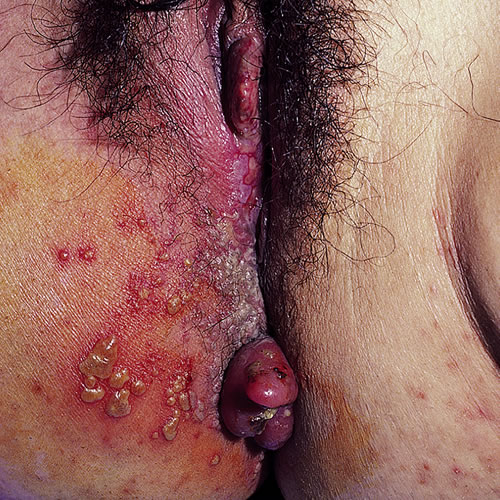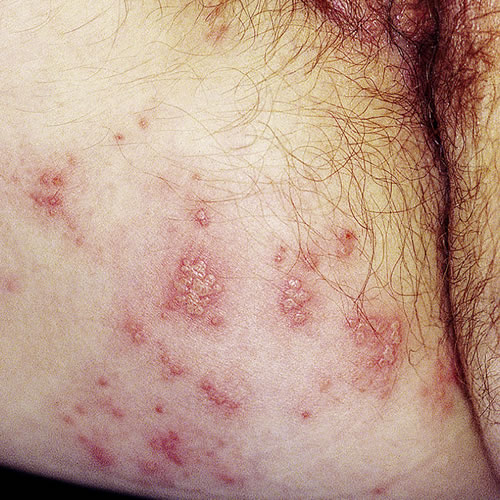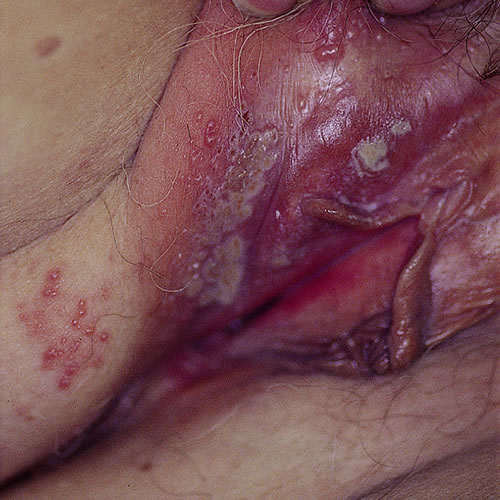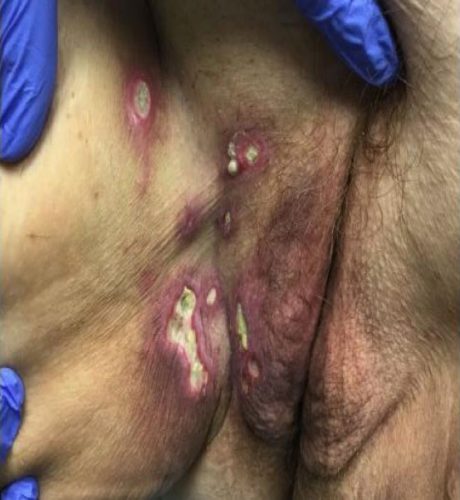Introduction
Primary infection with varicella-zoster virus (VZV) commonly occurs as chickenpox, a childhood disease that, prior to the advent of varicella vaccine use in 1995, infected 99.5% of the US population. After patient recovery from primary infection, the VZV lies dormant in sensory nerve ganglia.1 Herpes zoster, also known as shingles, occurs when latent VZV reactivates and spreads down the sensory nerve to establish infection in the skin. Herpes zoster most commonly presents as an acute, vesicular, painful skin eruption that occurs unilaterally in a dermatomal distribution.2 Children who get the varicella vaccine have a lower risk of herpes zoster compared with people who were infected with wild-type VZV, but reactivation from the vaccine itself may occur, if rarely.3 In this topic, we will review herpes zoster generally and devote specific attention to diagnosing and treating herpes zoster occurring in the anogenital region.
Epidemiology
Anyone who has had primary varicella infection or varicella vaccination can develop herpes zoster. The United States Centers for Disease Control and Prevention (CDC) estimates that approximately 30% of persons in the United States will experience herpes zoster during their lifetime. The epidemiology is similar worldwide. It is more common in females than in males and approximately 50% less common in blacks than in whites. Most will have only one episode of herpes zoster, but recurrences can occur, in the range of 1-6%, more frequently in immunocompromised people.4 Genital dermatomes are involved in up to 2% of herpes zoster cases.5
Etiology
The reasons that VZV reactivates and herpes zoster affects a particular nerve dermatome are not well understood. That said, the risk of developing herpes zoster increases as VZV-specific, cell-mediated immunity declines, whether from advancing age, certain medical condtitions (cancer, HIV, bone marrow or organ transplant) or medications that suppress the immune system such as steroids, chemotherapy, or transplant-related drugs.6
Symptoms and clinical manifestations
Typical localized herpes zoster, characterized by a unilateral, painful, vesicular skin eruption distributed over one or two contiguous dermatomes, is the most common presentation. Less commonly, patients may develop “disseminated” zoster in which three or more dermatomes are affected. Disseminated zoster is more likely to occur in immunosuppressed patients. “Zoster sine herpete” describes infrequent cases in which the patient develops the dermtomal pain typical of herpes zoster, without the associated skin eruption.
Most patients with typical herpes zoster will initially notice unilateral, prodromal paresthesias, without any visible skin changes. Prodromal symptoms precede the onset of the skin eruption by a few days and may be described as tingling, burning, sharp or throbbing pain, or itch in the affected area. Some patients will also have early systemic symptoms such as fever, fatigue, and headache.7
The morphology of the skin eruption evolves over the course of the illness, usually starting as crops of red papules and plaques on a dermatomal distribution. Over three to five days, groups of small, clustered vesicles (and sometimes pustules) develop on the red-based papule. In areas that are exposed to friction from clothing and activity, including the anogenital region, the vesicles and pustules may become unroofed and appear as erosions. Such erosions occurring in the anogenital region may trigger complaints of pain with urination and bowel movements.8
Over the following two to four weeks, the lesions dry, become crusted, and heal. The inflammation from the skin eruption may leave residual pigmentary changes and scarring. Pain and other symptoms gradually improve as the skin eruption resolves. Prolonged pain localized to the affected area for more than 90 days after onset is known as post-herpetic neuralgia (PHN) and can last for months or even years.9




Diagnosis
In general, the diagnosis of herpes zoster can be made clinically when the history and exam show typical findings of a unilateral, painful, vesibular eruption in a dermatomal distribution. However, herpes zoster occurring in the anogenital region can be difficult to distinguish from herpes simplex infection, and immunocompromised patients may present with atypical history and exam. If the clinical presentation is uncertain, and in all cases where clinical features overlap with genital herpes simplex infection or where recurrent herpes zoster is suspected, laboratory confirmatioin of the diagnosis is indicated.10 Edwards and Lynch point out that herpes zoster is usually a one-time occurrence while herpes simplex recurs.11
Pathology/Laboratory Findings
Diagnostic techniques available to assist with the diagnosis of herpes zoster include polymerase chain reaction (PCR) assays, viral culture, direct fluorescent antibody (DFA) testing, serology, and histopathology. PCR testing is the preferred test to provide timely (<1 day) and sensitive (>95%) confirmation of VZV from clinical specimens obtained from all stages of skin lesions. 12 13The results from viral cultures take longer than PCR tests and are less sensitive. DFA and serologies have limited value in clinical care of the patient.14
Histopathology from biopsy of a skin eruption triggered by either VZV or herpes simplex virus (HSV) most commonly shows intraepidermal vesicles with variable degrees of epithelial necrosis, and keratinocytes with ballooned nuclei and giant multinucleated cells. Histopathology cannot distinguish between HSV and VZV.1516 If a bullous dermatosis is suspected, a 4mm punch biopsy of perilesional skin submitted for direct immunofluorescent staining may be warranted.
Differential diagnosis
Differential diagnosis includes herpes simplex, cellulitis, contact dermatitis, and bullous impetigo or pemphigoid.
Treatment/management
A comprehensive management plan for herpes zoster should first address educating and reassuring the patient regarding the risk of transmission. While patients with active herpes zoster are much less likely to transmit the virus compared with an individual with primary varicella, VZV from a herpes zoster lesion can be spread by direct contact or via aerosolization of the virus from skin lesions during the time that vesicles are present until the lesions have become dry and crusted.17 A patient with active herpes zoster can potentially transmit VZV, causing varicella (chickenpox), to individuals who have not had varicella and have not received the varicella vaccine.
Treatment should be focused on increasing speed of healing, managing pain, decreasing viral shedding, and preventing PHN.
Non-specific care for the acute swollen vulva consists of the following:
- A sitz bath or a cool compress 2 to 3 times a day to decrease the swelling and to heal the blisters.
- For pain, use lidocaine-prilocaine cream (EMLA) applied in a thick layer under plastic wrap for 20 minutes for local anesthesia as needed.
- Catheterization and sedation may be necessary.
- Acetomeniphen alternating with ibuprofen may be helpful for pain.
Specific treatment includes:
- Acyclovir (Zovirax) 800 mg orally at 7:00 and 11:00 AM and 3:00, 7:00, and 11:00 PM x 7 days, used most commonly in pregnant women
- Famciclovir (Famvir) 500 mg orally 3 times a day x 7 days
- Valacyclovir (Valtrex) 1g orally 3 times a day x 7 days if renal function is normal
For severe disease, prescribe:
- Acyclovir (Zovirax) 10 mg/kg IV q8h x 7 days
For immunosuppressed patients, prescribe:
- Foscarnet (Foscavir) 40 mg/kg IV q8h x 7 to 10 days (only if intolerant to acyclovir)
For pain control, prescribe:
- Acetaminophen and codeine 15 to 30 mg orally q3-4h
- Gabapentin 300 mg at bedtime. Increase by 300 mg every two days to 1000 mg if necessary
- OR
- Pregabalin 50 mg at bedtime. Increase by 50 mg every three days to 150-300 mg if needed.
Herpes zoster of the vulva and the dermatomes S1 through S4 can be incapacitating as well as demoralizing and depressing. Early institution of gabapentin or pregabalin may reduce the zoster-associated pain complex. Usually the lesions settle in three to four weeks with some degree of scarring. Especially in the elderly, post-herpetic neuralgia may result. The use of prednisone to prevent the neuralgia is controversial.
Prevention of herpes zoster with the recombinant zoster vaccine series (RZV) marketed as Shingrix is recommended per CDC guidelines in immunocompetent people greater than or equal to age 19. Because herpes zoster can recur, adults with a history of herpes zoster should receive the recombinant zoster vaccine series once symptoms have completely resolved.18
For more on herpes zoster, see the CDC website: http://www.cdc.gov/shingles/index.html
References
- Centers for Disease Control and Prevention, 2022. https://www.cdc.gov/vaccines/vpd-vac/shingles/downloads/vzv_clinical_slideset_jul2010.pdf
- Fisher BK, Margesson, LJ. Genital Skin Disorders: Diagnosis and Treatment. Mosby, Inc., 1998. 133-134.
- Center for Disease Controls and Prevention, 2022. https://www.cdc.gov/vaccines/vpd-vac/shingles/downloads/vzv_clinical_slideset_jul2010.pdf
- Centers for Disease Control and Prevention, 2022. Shingles: Clinical Overview. https://www.cdc.gov/shingles/hcp/clinical-overview.html
- Magdaleno-Tapial J, et al. Genital Herpes Zoster: A rare location that can mimic genital herpes. Sex Transm Dis. 2022. Jan 1;49(1):e34-e36.
- United States Centers for Disease Control and Prevention. 2022. Shingles Surveillance. http://www.cdc.gov/shingles/surveillance.html
- Centers for Disease Control and Prevention, 2022. Shingles: Clinical Overview. https://www.cdc.gov/shingles/hcp/clinical-overview.html
- Edwards L and Lynch PJ. Genital Dermatology Atlas and Manual, second edition. Wolters Kluwer. 2018. p 169
- Centers for Disease Control and Prevention, 2022. Shingles: Clinical Overview. https://www.cdc.gov/shingles/hcp/clinical-overview.html
- Birch CJ, Druce JD, Catton MC, et al. Deection of varicella zoster virus in genital specimens using a mutiplex polymerase chain reaction. Sex Transm Infect. 2003 Aug:79(4):298-300
- Edwards L and Lynch PJ. Genital Dermatology Atlas and Manual, second edition. Wolters Kluwer. 2018. p 170
- Stránská R, Schuurman R, de Vos M, van Loon AM. Routine use of a highly automated and internally controlled real-time PCR assay for the diagnosis of herpes simplex and varicella-zoster virus infections. J Clin Virol 2004; 30:39
- Edwards L and Lynch PJ. Genital Dermatology Atlas and Manual, second edition. Wolters Kluwer. 2018. p 170.
- United States Centers for Disease Control and Prevention. 2022. Shingles Surveillance. http://www.cdc.gov/shingles/surveillance.html
- Leinweber B, Kerl H, Cerroni L. Histopathologic Features of Cutaneous Herpes Virus Infections (Herpes Simplex, Herpes Varicella/Zoster), The American Journal of Surgical Pathology: January 2006 – Volume 30 – Issue 1 – p 50-58
- Edwards L and Lynch PJ. Genital Dermatology Atlas and Manual, second edition. Wolters Kluwer. 2018. p 169
- United States Centers for Disease Control and Prevention. Shingles Surveillance. 2022. http://www.cdc.gov/shingles/surveillance.html
- Dooling KL, et al. Recommendations of the Advisory Committee on Immunization Practices for Use of Herpes Zoster Vaccines. MMWR Morb Mortal Wkly Rep 2018;67:103-8